Plantaris: Learn Your Muscles
The plantaris is not a primary mover. In fact, it only assists in movement. However, because of the role it plays in bending the knee and pointing the foot at the ankle, it can still cause pain and dysfunction. Since it is not a primary mover, it can easily be overlooked when trying to diagnose and identify causes of pain.
Location

Thanks to christineshipjoint.blogspot.com for the image.
The plantaris originates on the lateral supracondylar ridge of the femur above the lateral head of the gastrocnemius. Right. Let’s take a moment to break that down so that it makes sense.
“Lateral” means that the location will be to the outside, and we know the femur is the thigh bone. In Latin, “supra” means above. Condyles are the nubs at the bottom of the femur. So, the insertion of the plantaris is just to the outside of center at the very bottom of the shaft of the femur. This places it right above the head of the gastrocnemius.
The plantaris inserts medially on the posterior surface of the calcaneus. This means that the insertion is medial to the Achilles tendon. The relationship of the plantaris to the Achilles tendon is important because this muscle and tendon are commonly recognized as culprits of heel and foot pain known as plantar fasciitis.
Function
Since the plantaris originates on the femur, it assists with flexion of the knee. This means that, although it is not a primary mover, it does help other muscles to bend the knee. At the ankle, it assists with plantar flexion (pointing the foot at the ankle) and inversion of the foot (turning the sole of the foot toward the midline of the body).
Common Dysfunction
When the plantaris is not working correctly, it can cause knee pain. The pain is present behind the knee and may go down the back of the calf. Sometimes, it can also cause cramps in the calf.
The plantaris is probably best know because of its association with plantar fasciitis. A while ago, I talked about how everything inside us is covered in fascia. When healthy, fascia should cover muscles, organs, etc. and slide with ease. However, when injured, fascia will adhere to neighboring fascia. Also, fascia can also become inflamed. This is called fasciitis.
Plantar fasciitis is a very common dysfunction. Most notably, you will feel pain in your heel or on the sole of your foot. In many cases, you can successfully treat plantar fasciitis yourself, however, sometimes surgery is required.
When in doubt, it is always best to consult your physician. Muscles can be seriously injured and medical professionals can order imaging, medicine, and therapy to best suit your situation.
Restoring or Maintaining Health
If you are having knee pain, you can begin by making sure you’re not locking your knees. When the knee is straight and the foot is reaching toward the shin, strain can be put on the plantaris. This movement is found in activities such as running, riding a bike, and going down stairs.
If you are suffering from plantar fasciitis, I have some suggestions. A while ago, I wrote an article, “Fix Your Plantar Fasciitis!” The article contains 5 exercises you can do to improve your plantar fasciitis. In my case, I got rid of it entirely within a month or so.
More Information
To read more on the plantaris, I suggest two articles from The Wellness Digest: “Plantaris Muscle Anatomy: Origin, Insertion, Action, Innervation” and “Plantaris Muscle: Pain Behind The Knee.”
For more information on plantar fasciitis, here is a link to WebMd.
Also, I consulted my [easyazon_link identifier=”1878576003″ locale=”US” tag=”custpilandyog-20″]Flash Anatomy Muscles Flash Cards[/easyazon_link]. If you’re really enjoying anatomy and are wanting a tool to help you locate specific muscles correctly, I highly recommend these flash cards. I turn to them any time a client comes in with pain.
Listed above is a link to buy them on Amazon. If you purchase them from this link, I earn a small commission.
Have you ever had issues with your plantaris? What did you do to resolve them? Let us know in the comments below.
Thank you for reading this article. If you enjoy the information supplied, please consider supporting this website!
Sign up for our newsletter to get more tips for health and happiness! Also, you can find us on Facebook, YouTube and Pinterest as Custom Pilates and Yoga.
Nice information and thanks for sharing this with us. You can find some knee treatments by visiting our site- Treatment for Knee Pain the latest pain treatment modalities available on the market. This blog is realy helpful.
pain managment doctors
Thanks, Benny!